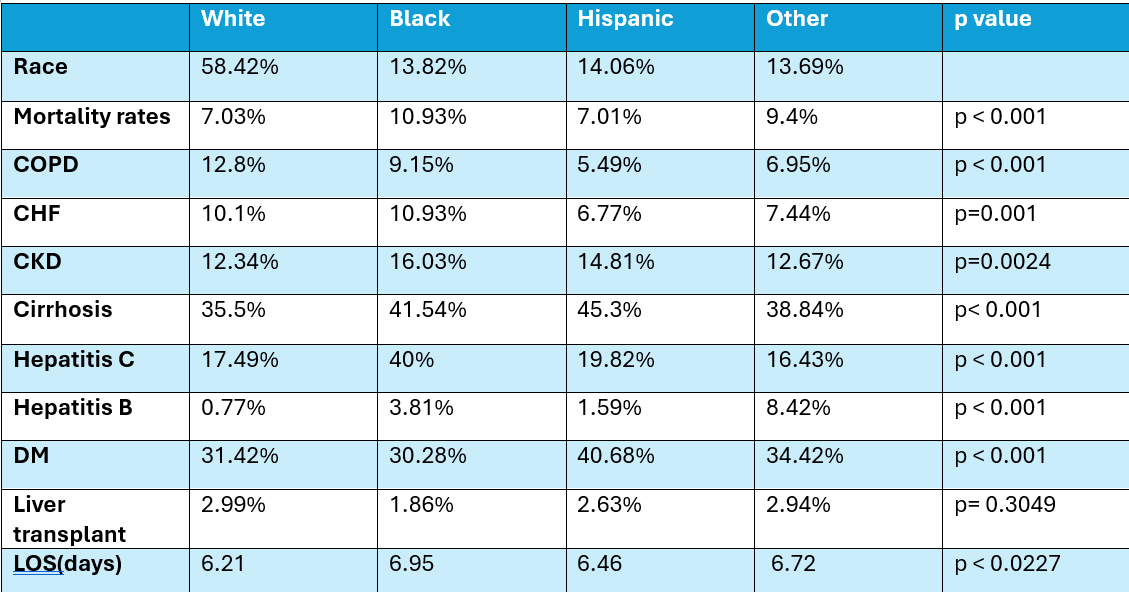Tuesday Poster Session
Category: Liver
P5937 - Impact of Race and Socioeconomic Factors on Liver Cancer: A Nationwide Analysis
Tuesday, October 28, 2025
10:30 AM - 4:00 PM PDT
Location: Exhibit Hall
- MA
Mohammad Alqaisieh, MD
Hamilton Health Care System
Dalton, Georgia
Presenting Author(s)
Maheshkumar Desai, MD, Bugra Zengin, MD, Mohammad Alqaisieh, MD, Jasneet Randhawa, MD, Zaid Zahid, MD
Hamilton Health Care System, Dalton, GA
Introduction: Liver cancer is the sixth most common cancer globally and the third leading cause of cancer-related deaths, with hepatocellular carcinoma as the predominant subtype. This study examines liver cancer prevalence, length of hospital stay (LOS), total hospital charges, and comorbidities across racial groups.
Methods: Patients discharged in 2019–2020 were identified from the Nationwide Inpatient Sample (NIS) database and categorized by racial identity and a primary diagnosis of liver cancer using ICD-10 codes. Statistical analyses assessed prevalence, LOS, total charges, and comorbidity patterns (e.g., diabetes, Hepatitis B/C, cirrhosis, CHF, CKD, and COPD) across racial groups.
Results: Among 44,665 patients (65.73% male, mean age 65.23 years), racial distribution was 58.42% White, 13.82% Black, 14.06% Hispanic, and 13.69% Other. Mortality was highest in Black (10.93%) and Other groups (9.4%) vs. White (7.03%) and Hispanic (7.01%) (p < 0.001).
Comorbidities varied by race (see table). COPD and CHF were more common in White and Black patients. CKD, cirrhosis, and Hepatitis C were more prevalent in Black and Hispanic patients. Hepatitis B was more frequent in Black and Other groups. Diabetes was highest in Hispanic (40.68%) and Other groups (34.42%) (p < 0.001).
Mean LOS was 6.21 days (White), 6.95 (Black), 6.46 (Hispanic), and 6.72 (Other) (p = 0.0227). Regionally, Hispanic patients were mainly hospitalized in the South (36.15%) and West (38.61%), Black in the South (53.2%), White in the South (39.09%), and Other in the West (36.14%) (p < 0.001).
Black (52.1%) and Hispanic (40.07%) patients were mostly in the lowest income quartile (p < 0.001). Liver transplant rates did not differ significantly (p = 0.3049).
Discussion: Liver cancer outcomes and comorbidities vary significantly by race, reflecting disparities in access to care, socioeconomic status, and geographic trends. Black and Hispanic patients had a higher prevalence of advanced disease markers like cirrhosis and Hepatitis C, with Black patients experiencing the highest mortality. These disparities highlight the need for targeted interventions and equitable care strategies to improve liver cancer outcomes.

Figure: Race distribution, mortality rates, and comorbidity prevalences across racial groups
Disclosures:
Maheshkumar Desai indicated no relevant financial relationships.
Bugra Zengin indicated no relevant financial relationships.
Mohammad Alqaisieh indicated no relevant financial relationships.
Jasneet Randhawa indicated no relevant financial relationships.
Zaid Zahid indicated no relevant financial relationships.
Maheshkumar Desai, MD, Bugra Zengin, MD, Mohammad Alqaisieh, MD, Jasneet Randhawa, MD, Zaid Zahid, MD. P5937 - Impact of Race and Socioeconomic Factors on Liver Cancer: A Nationwide Analysis, ACG 2025 Annual Scientific Meeting Abstracts. Phoenix, AZ: American College of Gastroenterology.
Hamilton Health Care System, Dalton, GA
Introduction: Liver cancer is the sixth most common cancer globally and the third leading cause of cancer-related deaths, with hepatocellular carcinoma as the predominant subtype. This study examines liver cancer prevalence, length of hospital stay (LOS), total hospital charges, and comorbidities across racial groups.
Methods: Patients discharged in 2019–2020 were identified from the Nationwide Inpatient Sample (NIS) database and categorized by racial identity and a primary diagnosis of liver cancer using ICD-10 codes. Statistical analyses assessed prevalence, LOS, total charges, and comorbidity patterns (e.g., diabetes, Hepatitis B/C, cirrhosis, CHF, CKD, and COPD) across racial groups.
Results: Among 44,665 patients (65.73% male, mean age 65.23 years), racial distribution was 58.42% White, 13.82% Black, 14.06% Hispanic, and 13.69% Other. Mortality was highest in Black (10.93%) and Other groups (9.4%) vs. White (7.03%) and Hispanic (7.01%) (p < 0.001).
Comorbidities varied by race (see table). COPD and CHF were more common in White and Black patients. CKD, cirrhosis, and Hepatitis C were more prevalent in Black and Hispanic patients. Hepatitis B was more frequent in Black and Other groups. Diabetes was highest in Hispanic (40.68%) and Other groups (34.42%) (p < 0.001).
Mean LOS was 6.21 days (White), 6.95 (Black), 6.46 (Hispanic), and 6.72 (Other) (p = 0.0227). Regionally, Hispanic patients were mainly hospitalized in the South (36.15%) and West (38.61%), Black in the South (53.2%), White in the South (39.09%), and Other in the West (36.14%) (p < 0.001).
Black (52.1%) and Hispanic (40.07%) patients were mostly in the lowest income quartile (p < 0.001). Liver transplant rates did not differ significantly (p = 0.3049).
Discussion: Liver cancer outcomes and comorbidities vary significantly by race, reflecting disparities in access to care, socioeconomic status, and geographic trends. Black and Hispanic patients had a higher prevalence of advanced disease markers like cirrhosis and Hepatitis C, with Black patients experiencing the highest mortality. These disparities highlight the need for targeted interventions and equitable care strategies to improve liver cancer outcomes.

Figure: Race distribution, mortality rates, and comorbidity prevalences across racial groups
Disclosures:
Maheshkumar Desai indicated no relevant financial relationships.
Bugra Zengin indicated no relevant financial relationships.
Mohammad Alqaisieh indicated no relevant financial relationships.
Jasneet Randhawa indicated no relevant financial relationships.
Zaid Zahid indicated no relevant financial relationships.
Maheshkumar Desai, MD, Bugra Zengin, MD, Mohammad Alqaisieh, MD, Jasneet Randhawa, MD, Zaid Zahid, MD. P5937 - Impact of Race and Socioeconomic Factors on Liver Cancer: A Nationwide Analysis, ACG 2025 Annual Scientific Meeting Abstracts. Phoenix, AZ: American College of Gastroenterology.
